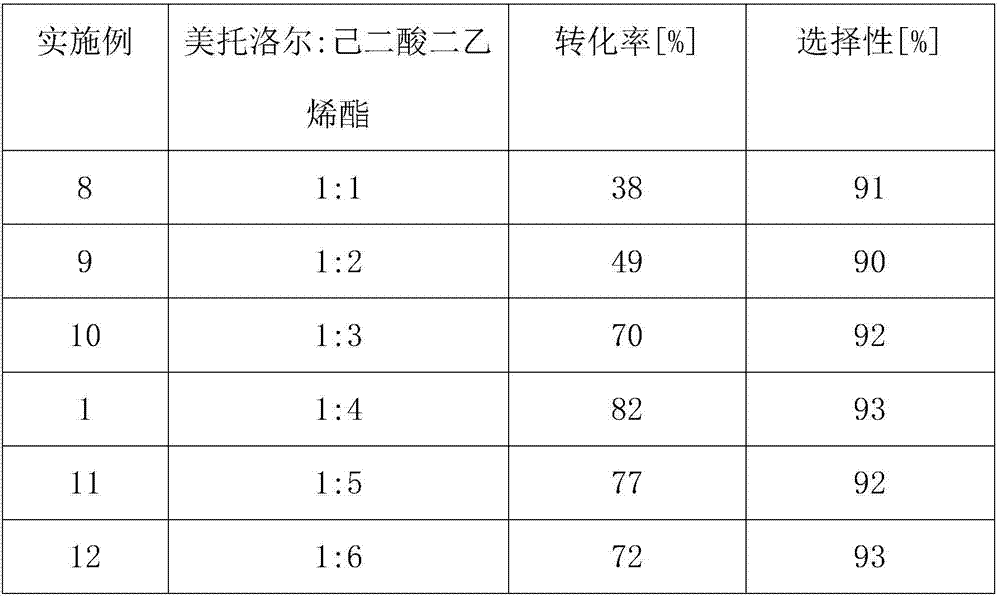Method for on-line synthesis of N-(5-vinyl ester valeryl) metoprolol through catalysis by lipase
A vinyl ester valeryl and lipase technology, applied in biochemical equipment and methods, biological material sampling methods, biochemical instruments, etc., can solve the problems of long reaction time, low conversion rate and selectivity, and reduce the reaction cost , short reaction time, high conversion and selectivity
- Summary
- Abstract
- Description
- Claims
- Application Information
AI Technical Summary
Problems solved by technology
Method used
Image
Examples
Embodiment 1
[0028] Embodiment 1: the synthesis of N-(5-vinyl pentanoyl) metoprolol
[0029]
[0030] Dissolve metoprolol (1.0mmol) in 2.50mL of DMSO and 7.50mL of tert-amyl alcohol, and dissolve divinyl adipate (4.0mmol) in 2.50mL of DMSO and 7.50mL of tert-amyl alcohol, and then fill them into 10mL syringes in spare. 0.87g of lipase Lipozyme TLIM was evenly filled in the reaction channel, driven by the PD 1200 syringe pump, the two reaction solutions were separated at 10.4 μL min -1 The flow rate entered the reaction channel through the "Y" joint for reaction, and the temperature of the reactor was controlled at 50°C by a water bath thermostat. The reaction solution was continuously flowed in the reaction channel for 30 minutes, and the reaction results were tracked and detected by thin-layer chromatography (TLC).
[0031] The reaction solution was collected online by the product collector, the solvent was removed by distillation under reduced pressure, and the column was wet packed wi...
Embodiment 2-7
[0036] Change organic solvent (DMSO: tert-amyl alcohol) volume ratio in microfluidic channel reactor, control temperature is 50 ℃, other is the same as embodiment 1, and reaction result is as shown in table 1:
[0037] Table 1: Influence of the reaction medium on the reaction
[0038] Example
[0039] The results in Table 1 show that when the flow rate is 10.4 μL min -1 , the reaction time is 30min, the reaction temperature is 50 ℃, the ratio of the amount of reactant metoprolol and divinyl adipate is 1:2, and the conversion rate varies with the organic solvent (DMSO: tert-amyl Alcohol) volume ratio increases and increases, and when DMSO: tert-amyl alcohol volume ratio is 1:3, reaction conversion rate is the best, is 82%, if continue to increase the amount of tert-amyl alcohol in the reaction system now, will The incomplete dissolution of the reactants leads to a decrease in the conversion rate of the reaction. Therefore, the optimal reaction medium volume ratio in...
Embodiment 8-12
[0041] Change the ratio of the amount of substrate substance of metoprolol and divinyl adipate in the microfluidic microchannel reactor, control temperature 50 DEG C, other are with embodiment 1, and result is as shown in table 2:
[0042] Table 2: the impact of the ratio of the amount of metoprolol and divinyl adipate substrate substance on the reaction
[0043]
[0044] The results in Table 2 show that when the flow rate is 10.4 μL min -1 , the reaction time is 30min, the reaction temperature is 50 DEG C, the organic solvent DMSO in the reactor: tert-amyl alcohol volume ratio is 1:3, along with the increase of the reactant divinyl adipate, the conversion rate of the reaction also increases. Along with increasing, when the ratio of the amount of substrate substance is 1:4, the conversion rate of reaction is optimal, so the ratio of the amount of optimum substrate substance in the microfluidic microchannel reactor of the present invention is 1:4 .
PUM
 Login to View More
Login to View More Abstract
Description
Claims
Application Information
 Login to View More
Login to View More - R&D Engineer
- R&D Manager
- IP Professional
- Industry Leading Data Capabilities
- Powerful AI technology
- Patent DNA Extraction
Browse by: Latest US Patents, China's latest patents, Technical Efficacy Thesaurus, Application Domain, Technology Topic, Popular Technical Reports.
© 2024 PatSnap. All rights reserved.Legal|Privacy policy|Modern Slavery Act Transparency Statement|Sitemap|About US| Contact US: help@patsnap.com










